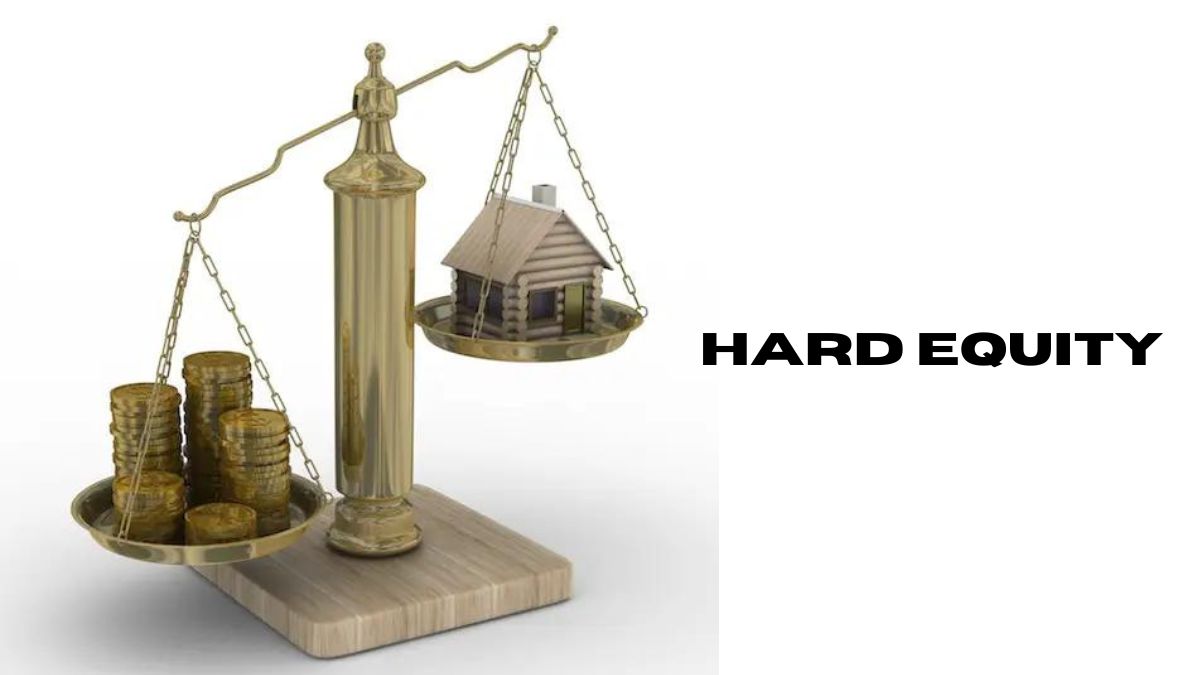BUSINESS
Introduction to Hard Equity

In the realm of investments, hard equity stands out as a robust and intriguing option. It represents a form of investment that involves tangible assets rather than financial instruments like stocks or bonds. Understanding the nuances of hard equity is essential for investors looking to diversify their portfolios and seek higher returns.
Understanding Hard Equity Investments
Hard equities investments involve putting money into physical assets such as real estate, commodities, or infrastructure projects. Unlike traditional investments where ownership is represented by shares or bonds, hard equity provides direct ownership of the asset. This direct ownership often translates to greater control over the investment and potential for higher returns.
Types of Hard Equity Investments
Hard equities investments come in various forms, including:
- Real estate properties
- Precious metals like gold and silver
- Infrastructure projects such as toll roads or bridges
- Natural resources like oil and gas wells
Each type of hard equities investment carries its own set of risks and rewards, making it crucial for investors to assess their risk tolerance and investment goals carefully.
Risks and Benefits
Like any investment, hard equity carries inherent risks. Market fluctuations, economic downturns, and regulatory changes can all impact the value of hard equity investments. However, the tangible nature of these assets can provide a level of security not found in purely financial instruments.
On the flip side, hard equity investments have the potential for significant returns, especially in periods of economic growth or inflation. Additionally, they offer diversification benefits to portfolios traditionally weighted towards stocks and bonds.
Factors Influencing Hard Equity Investments
Several factors influence the performance of hard equities investments, including:
Economic Conditions
The overall state of the economy plays a significant role in the success of hard equity investments. During periods of economic growth, demand for real estate and infrastructure tends to increase, driving up prices and returns for investors. Conversely, economic downturns can lead to declines in asset values and lower returns.
Market Trends
Market trends also play a crucial role in determining the performance of hard equity investments. Shifts in consumer preferences, technological advancements, and geopolitical events can all impact the demand for certain types of hard equity assets. Staying abreast of these trends is essential for investors looking to capitalize on opportunities and mitigate risks.
How to Invest in Hard Equity
Investing in hard equity requires careful planning and due diligence. Here are some steps to consider:
Research and Due Diligence
Before investing in hard equity, it’s essential to conduct thorough research on the asset class and specific investment opportunities. This may involve analyzing market trends, assessing the financial viability of projects, and evaluating potential risks.
Finding Opportunities
Once you’ve identified promising investment opportunities, it’s crucial to assess their suitability for your portfolio. Consider factors such as the expected return on investment, the level of risk involved, and how the investment aligns with your overall investment strategy.
Hard Equity vs. Other Investment Vehicles
Comparison with Stocks and Bonds
One of the primary distinctions between hard equities and traditional investments like stocks and bonds is the nature of the assets involved. While stocks and bonds represent ownership in companies or debt obligations, hard equity investments provide direct ownership of physical assets.
Real Estate vs. Hard Equity
Real estate investments are often considered a subset of hard equity investments. While both involve investing in tangible assets, real estate typically refers to residential or commercial properties, whereas hard equity encompasses a broader range of physical assets.
Managing Risks in Hard Equity Investments
Given the inherent risks associated with hard equities investments, it’s essential to implement risk management strategies to protect your capital. Here are some tips:
Diversification
Diversifying your hard equities portfolio across different asset classes and industries can help mitigate the impact of adverse market conditions. By spreading your investments across multiple assets, you reduce the risk of significant losses from any single investment.
Risk Management Strategies
Implementing risk management strategies such as stop-loss orders, hedging, and portfolio rebalancing can help limit potential losses and protect your investment capital. These strategies are designed to minimize downside risk while maximizing upside potential.
The Future of Hard Equities
As global markets continue to evolve, the future of hard equity looks promising yet uncertain. Emerging trends such as sustainable investing, technological innovation, and infrastructure development present new opportunities for investors. However, geopolitical tensions, regulatory changes, and environmental concerns could pose challenges to the growth of the hard equity market.
Emerging Trends
One of the notable trends shaping the future of hard equities is the growing emphasis on sustainability and environmental responsibility. Investors are increasingly seeking opportunities in renewable energy, green infrastructure, and eco-friendly real estate projects.
Forecast for the Market
While the outlook for hard equities investments remains positive, investors should proceed with caution and carefully assess market conditions and investment opportunities. By staying informed and adapting to changing trends, investors can position themselves for success in the dynamic world of hard equity’s investing.
Conclusion
Hards equity investments offer a compelling opportunity for investors seeking to diversify their portfolios and achieve higher returns. By understanding the fundamentals of hard equity, conducting thorough research, and implementing risk management strategies, investors can navigate the complexities of this asset class with confidence.
BUSINESS
The Necessity of AI Calling Software in Modern Companies

AI has rapidly transformed various industries; call centers and outsourcing are no exceptions. Integrating AI into these sectors has revolutionized how businesses operate, enhancing efficiency, reducing costs, and improving customer satisfaction.
Let’s now look into the transformative role of AI in modern call center solutions and outsourcing, highlighting its benefits, key technologies, trends, and future outlook.
The Era Change: AI in Call Centers
Previously, call centers faced numerous challenges, including high operational costs, inefficiency in handling large volumes of calls, and inconsistent customer service.
The introduction of AI has addressed these issues by automating routine tasks, providing data-driven insights, and enabling personalized customer interactions.
Traditional Challenges in Call Centers:
- High operational costs due to large staff requirements.
- Inconsistent customer service quality.
- Inefficiency in handling peak call volumes.
AI to the Rescue:
- Automation of repetitive tasks like call routing and answering common queries.
- Enhanced data analytics for better decision-making.
- Personalization of customer interactions through AI-driven insights.
An AI call center is what you need today to make more sales revenue and save more money.
Benefits of AI in Call Centers
AI offers loads of benefits that enhance the efficiency and effectiveness of call centers:
Efficiency and Productivity:
- AI automates routine tasks, freeing up human agents to handle more complex issues.
- Chatbots and virtual assistants can manage a large volume of inquiries simultaneously, reducing wait times and improving customer satisfaction.
Enhanced Customer Experience:
- AI enables personalized customer interactions by analyzing data and predicting customer needs.
- AI-driven tools can provide real-time assistance to agents, helping them resolve issues faster.
Cost Reduction:
- Automation of tasks reduces the need for large call center staff, cutting down operational costs.
- AI systems can operate 24/7 without additional costs, unlike human agents.
Scalability:
- AI solutions can easily scale to handle increased call volumes without compromising performance.
- This scalability is crucial during peak times or unexpected surges in customer inquiries.
Key AI Technologies in Call Centers
Several AI technologies play a pivotal role in modern call centers:
Natural Language Processing (NLP):
- NLP enhances human-machine communication by enabling AI systems to understand and respond to human language.
- This technology powers chatbots and virtual assistants, making them more effective in handling customer queries.
Machine Learning (ML):
- ML algorithms continuously learn and improve from data, optimizing call center operations over time.
- Predictive analytics powered by ML helps in forecasting customer needs and behaviors.
Voice Recognition:
- Voice recognition technology streamlines customer interactions by enabling voice-based navigation and query resolution.
- It enhances the efficiency of IVR (Interactive Voice Response) systems.
Trends in AI Call Center Solutions
Several trends are shaping the future of AI in call centers:
Integration with CRM:
- AI systems are increasingly being integrated with Customer Relationship Management (CRM) tools.
- This integration provides a holistic view of customer interactions, enabling more personalized and effective service.
Omnichannel Support:
- AI enables consistent support across multiple channels, including phone, email, chat, and social media.
- This omnichannel approach ensures that customers receive seamless service regardless of the communication medium.
Predictive Analytics:
- AI-powered predictive analytics help in anticipating customer needs and proactively addressing issues.
- This trend is particularly useful in enhancing customer retention and satisfaction.
AI in Outsourcing: A New Era
AI integration in outsourcing is transforming the traditional outsourcing model, leading to what can be termed “Outsourcing 2.0.” AI enhances the capabilities of outsourcing services, making them more efficient, cost-effective, and innovative.
Outsourcing 2.0:
- AI-driven automation of routine tasks improves efficiency and reduces costs.
- Advanced data analytics provide insights that enhance decision-making and service quality.
- AI-powered tools enable real-time monitoring and management of outsourced processes.
Enhanced Capabilities:
- AI enhances the quality of outsourcing services by providing data-driven insights and automation.
- It enables outsourcing providers to offer more value-added services, such as predictive analytics and personalized customer interactions.
Strategic Implementation:
- Successful integration of AI in outsourcing requires careful planning and strategy.
- Businesses need to assess their specific needs and select the right AI tools and technologies.
Case Studies and Industry Applications
AI is making significant strides across various industries, transforming how businesses interact with customers and manage operations.
Retail Sector:
- AI-driven customer support systems in retail handle inquiries about products, orders, and returns efficiently.
- Personalized marketing through AI helps in targeting customers with relevant offers.
IT & SaaS Companies:
- AI applications in IT service management streamline support processes and enhance customer satisfaction.
- Predictive maintenance powered by AI reduces downtime and improves service reliability.
Healthcare:
- AI assists in patient support by providing accurate and timely information about medical conditions and treatments.
- Virtual health assistants powered by AI improve the efficiency of healthcare services.
Challenges and Considerations
While AI offers several benefits, its integration into call centers and outsourcing also presents challenges that need to be addressed:
Data Privacy:
- Ensuring the secure handling of customer data is paramount.
- Businesses must comply with data protection regulations and implement robust security measures.
Workforce Impact:
- The automation of tasks may lead to concerns about job displacement.
- It is essential to strike a balance between automation and human roles, ensuring that employees are upskilled and redeployed in value-added tasks.
Algorithm Bias:
- AI systems can inadvertently perpetuate biases present in the training data.
- Continuous monitoring and refinement of AI algorithms are necessary to mitigate bias and ensure fairness.
Future Outlook
The future of AI in call centers and outsourcing looks promising, with continuous innovation and adoption of advanced technologies.
Continuous Innovation:
- AI technologies are rapidly evolving, offering new possibilities for enhancing call center and outsourcing operations.
- Businesses must stay updated with the latest developments and invest in cutting-edge AI solutions.
Adoption Trends:
- The adoption of AI in call centers and outsourcing is expected to grow significantly in the coming years.
- Businesses across various sectors are recognizing the value of AI in improving efficiency, reducing costs, and enhancing customer satisfaction.
Long-term Benefits:
- The long-term benefits of AI integration include improved operational efficiency, better customer experiences, and increased competitiveness.
- Businesses that successfully leverage AI will be better positioned to thrive in the future.
Conclusion
AI is playing an important role in modern call center solutions and outsourcing, driving efficiency, cost savings, and enhanced customer experiences. By integrating AI technologies, businesses can stay ahead of the competition and deliver superior service to their customers.
BUSINESS
The Future of Salesforce Advisory Services: Trends and Predictions for 2024

Are you curious about how advanced software can transform business management? Imagine the impact of automation and accuracy in streamlining operations and boosting efficiency. Technological innovation has become essential for organizations to stay competitive and adaptable.
Salesforce advisory services are crucial in guiding companies through these technological advancements. Here, we delve into the latest trends and predictions for this advanced software in 2024. Discover how these insights can help you harness the power of Salesforce and drive your business forward.
The Rise of AI Interaction
The trend of integrating Artificial Intelligence (AI) is transforming how enterprises interact with Salesforce. In 2024, AI-powered predictive analytics will offer deeper insights into customer behavior, enabling more personalized interactions. AI-driven automation will streamline repetitive tasks, allowing advisors to focus on strategic planning and innovation.
Evolution of Systems Architecture
Systems architecture is undergoing significant changes. The transition to more modular, scalable architectures is on the horizon. Salesforce advisory software must adapt to these new frameworks to provide optimal solutions. This will enhance flexibility, making it easier for businesses to integrate and manage their CRM systems.
Advancements in CRM Strategies
‘Customer relationship management’ (CRM) strategies are evolving rapidly, influenced by new technologies and changing customer expectations. Based on recent trends, in 2024, there will be a stronger emphasis on data-driven decision-making. Advanced services will leverage analytics to craft more effective customer engagement strategies. This will involve harnessing real-time data to personalize marketing efforts and improve customer satisfaction.
Development of Advanced Salesforce Roadmaps
Salesforce roadmaps are becoming more sophisticated with the advancements of automation. Enterprises will require tailored roadmaps that align with their specific goals and challenges. In 2024, advisory services will create dynamic roadmaps adaptable to rapid changes in the business environment. This approach will assist companies to stay ahead of the curve and maximize their investment.
Cloud Strategy Innovations
Cloud computing continues to be a pillar of Salesforce solutions. The future of cloud strategy will focus on enhancing security and scalability. Advisory services will need to guide businesses through the complexities of multi-cloud environments. Effective cloud strategies will support seamless integration and ensure data integrity across platforms.
Agility in CRM Implementation
Contemporary trends highlight that agility will be a key factor in CRM implementation. As businesses face new challenges, adapting quickly will be crucial. In 2024, the advisory services will emphasize agile methodologies to ensure relevancy and effectiveness. This will involve iterative development and frequent adjustments based on real-time feedback.
Enhancements in Workforce Management
The role of the workforce in Salesforce advisory assistance is evolving. So, there will be a growing need for specialized skills and continuous learning. These services will focus on training and developing talent for advanced features and integrations. This will ensure enterprises can access the expertise to leverage their CRM systems.
Integration of Emerging Technologies
Emerging technologies will significantly shape these services. Blockchain and the Internet of Things (IoT) are expected to integrate more with CRM systems. In 2024, advisors must stay abreast of these innovations to provide forward-thinking solutions. This integration will enhance data security and expand the functionality of Salesforce applications.
Customer-Centric Approaches
The emphasis on customer-centricity will continue to grow. Such innovative solutions will need to prioritize strategies that enhance the user experience. This will involve developing solutions that support personalized communication and engagement. By focusing on the customer journey, enterprises can build stronger relationships and drive growth.
Sustainable CRM Practices
Sustainability is becoming increasingly important in all areas of business. Salesforce will begin to incorporate sustainable practices into its recommendations. This includes optimizing energy use in cloud services and supporting initiatives that reduce environmental impact. Sustainable practices will benefit the environment and enhance corporate reputation.
Therefore, the future of Salesforce advisory services is brimming with opportunities and challenges. To benefit from these innovations, consider using technological advancements to tailor solutions to your needs. How well is your current CRM strategy aligned with your business goals? Assessing your unique requirements will help you get the right solution, ensuring your business thrives in 2024.
BUSINESS
Essentials for Logistic Movers to Expand their Business Rapidly- Here’s How

Every type and size of business across the world needs to choose those steps that are highly effective and suitable for their positive growth. For instance, if you are involved in logistics, and freight moving business and you are willing to expand your business efficiently, the only reliable solution is to take wise steps. Without choosing the right options for your business, it will be hard enough to grow efficiently and rapidly. Those who are thinking well before taking their final step are rapidly growing their businesses. You should prefer heavy-duty trucks and trailers for moving the logistics and freight from one place to another for long distances. Heavy-duty trucks and trailers are a wise choice, and you should consider a truck financing option instead of buying one.
What is Truck financing, and Why should you consider it Compulsory?
Truck leasing or financing is the most preferred and reliable solution for logistics companies based worldwide. It si the solution that will allow you to expand your business by increasing the number of trucks by leasing or financing. Furthermore, buying a truck or trailer for commercial use will also charge you high, along with the tax amount included. Truck leasing or financing will give you reliable solutions to save money when buying a truck or trailer and use that money on other productive business tasks.
Just you have to find the truck owners around you and check their options that may give you the opportunity to lease truck or number of trucks for your logistic move business. It is a compulsory element to choose the heavy-duty trucks that can easily move the logistics from one place to another without hassle. The logistic items can be expensive and it is the only way that will built your trust on your clients in the market. If you are choosing the best trucks or trailers options, they will timely move and reach at the destination along with the logistic and freight.
Truck owners are always ready to help you in this situation and they will give yo the best options to choose the truck for leasing and a valid contract will be created. After the expiry of the contract, you need to change or upgrade the truck that you may not get from buying your own business asset.
How Do You Check for Truck Leasing options Around You?
It si not a difficult thing to check for the truck leasing option around you. We are living in a digital era and we can better search for the reliable and effective support in this regard. Feel free to read these points in detail and you might find this option more reliable and efficient.
- The best support of the internet will be more effective and efficient for you to search for the reliable service provider around your business.
- You can better ask for the referrals from anyone in your contact list and you will get the most reliable and effective solution.
- You can better check your available budget for this purpose and also you have to choose the truck for leasing option. If you find the best option for leasing under your targeted budget, avail that option.
- It will be a good option to choose more than an individual options offering truck leasing.
- Choose updated models for trucks or trailers for your business to boost its appearance in the market.
These points are much important and effective for everyone to follow seriously to get the right option for leasing a truck for commercial use. This is one of the most reliable options and there are several benefits for leasing a truck or trailer instead of buying.
What are the Quality Benefits for Leasing a Heavy-Duty Truck?
Do you live in Calgary, you must choose trailer financing Calgary to finance a truck or trailer for commercial use. All things will get set in a better way and you might find this option more reliable and useful.
- Truck financing will never demand for heavy initial deposit
- The depreciation effect will never apply on truck financer
- Can upgrade the truck or tariler once the contract will get expired
- A reasonable option for all types and sizes of businesses.

 Cartoon5 months ago
Cartoon5 months agoUnlocking the Potential of Nekopoi.care: A Comprehensive Guide

 Game4 months ago
Game4 months agoExploring Aopickleballthietke.com: Your Ultimate Pickleball Destination

 BUSINESS4 months ago
BUSINESS4 months agoWhat Companies Are In The Consumer Services Field

 HEALTH5 months ago
HEALTH5 months agoUnveiling the Mystery of Pikruos: A Comprehensive Guide

 HOME IMPROVEMENT5 months ago
HOME IMPROVEMENT5 months agoExploring the Events of 2023-1954: A Look Back in Time

 TECHNOLOGY4 months ago
TECHNOLOGY4 months agoUnderstanding Coomersu

 FASHION4 months ago
FASHION4 months ago5 Reasons Why Every Woman Needs a Long Sleeve Dress in Her Closet

 ENTERTAINMENT5 months ago
ENTERTAINMENT5 months agoThe Epic Return: Revenge of the Iron-Blooded Sword Hound
















